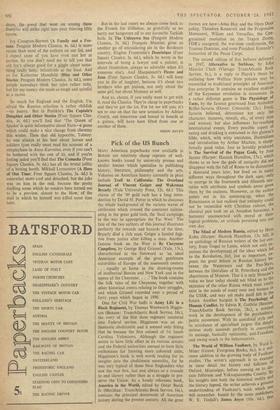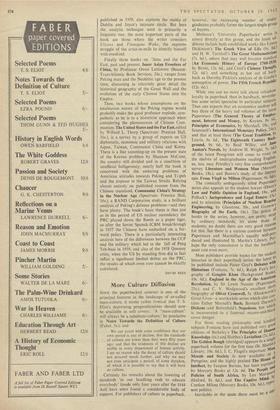Pick of the US Bunch
MANY American paperbacks now available in Britain are relatively cheap reprints of well- known books issued by university presses and similar houses which specialise in publishing history, literature, philosophy and the arts. Volumes on American history currently in print include Trail to California: The Overland Journal of Vincent Geiger and Wakeman Bryarly (Yale University Press, 12s. 6d.). This classic of the '49 gold rush has a long intro- duction by David M. Potter in which he discusses the whole background of the various waves of settlement which crossed the continent culmin- ating in the great gold rush, the 'final campaign in the war to appropriate the Far West.' The fate of the two authors of this journal illustrates perfectly the rewards and hazards of the time; Bryarly died a rich man, Geiger a hunted fugi- tive from justice after killing a man. Another famous book on the West is By Cheyenne Campfires, by George Bird Grinnel (Yale, 15s.), characterised in the foreword as 'an ideal American example of the great gentlemen naturalists of Europe of the nineteenth century • . equally at home in the drawing-rooms of intellectual Boston and New York and in the tepees of the Cheyenne. . . .' The book contains the folk tales of the Cheyenne, together with other historical events relating to their struggles, and which Grinnel recorded over a period of forty years which began in 1890.
One for Civil War buffs is Army Life in a Black Regiment, by Thomas Wentworth Higgin- son (Beacon: TransAtlantic Book Service, 16s.), the story of the first slave regiment mustered into Federal service. Higginson was an en- thusiastic abolitionist and it seemed only fitting that he became the first colonel of 1st South Carolina Volunteers. Although the regiment seems to have little effect in its various actions and the Federal authorities seemed to have little enthusiasm for forming more coloured units, Higginson's book is well worth reading for its insights into the abolitionist mentality, for he was very typical of those New Englanders who saw the war first, last and always as a crusade to end slavery rather than as a struggle to pre- serve the Union. As a handy reference book, America in the World, edited by Oscar Barck Jr. (Meridian: TransAtlantic Book Service, 16s.), contains the principal documents of American history during the present century. All the great themes are here—John Hay and the Open Door policy, Theodore Roosevelt and the Progressive
Movement, Wilson and Versailles, the Con- gressional resolution on the Teapot Dome, FDR's inaugural, the war-time conferences, the Truman Doctrine, and even President Kennedy's formation of the Peace Corps.
The second edition of five lectures delivered in 1947, Alternative to Serfdom, by John Maurice Clark (Vintage: TransAtlantic Book Service, 9s.), is a reply to Hayek's thesis by outlining how Welfare State policies may be reconciled to traditional principles of American
free -enterprise. It contains an excellent analysis of the Keynesian revolution in economics. In
a rather different genre is The Physiology of Taste, by the famous gourmand Jean Anthelme Brillat-Savarin (Dover: Constable, 12s.). Food, Savarin believed, determines not only the character, manners, morals, etc., of every man and woman, but also influences far-reaching international events. Every possible aspect of eating and drinking is contained in this glutton's bible, which, with witty anecdotes, illustrations and introduction by Arthur Machen, is excep- tionally good value. Just as lavishly produced is The Survival of the Pagan Gods, by Jean Seznec (Harper: Hamish Hamilton, 17s.), which shows to us how the gods of antiquity did not disappear with the fall of Rome to be disinterred a thousand years later, but lived on in many
different ways throughout the dark ages, only to emerge in the fourteenth and fifteenth cen- turies with attributes and symbols never given
them by the ancients. Moreover, as the author points out in his summing-up, when the Renaissance at last realised that antiquity could not be reconciled with Christian culture, the classical past took on an Arcadian harmony, a
harmony unconcerned with moral or theo- logical problems, an attitude persisting into our own day.
The Mind of Modern Russia, edited by Hans Kohn (Harper: Hamish Hamilton, 13s. 6d), Is
an anthology of Russian writers of the last cen- tury, from Gogol to Lenin, which not only ex- amines the development of the ideas which led to the Revolution, but, just as important, ex- poses the great debate in Russian history be- tween the Westerners and the Pan-Slays,
between the liberalism of St. Petersburg and the chauvinism of Moscow. That it is only Moscow's voice we hear today should not blind us to the
existence of the other Russia which must surelY exist in the minds of many men and women is the USSR, and may yet make itself felt in the future. Another bargain is The PsychologY 01. Human Conflict, by Edwin R. Guthrie (Beacon. TransAtlantic Book Service, 18s.), a seminal work in the development of the psychothera- peutic movement. With its anecdotal style and its avoidance of specialised jargon this deeplY serious study succeeds perfectly in conveying its message, basically optimistic, anti-Freudian, and owing much to the behaviourists.
The World of William Faulkner, by Ward Miner (Grove: Evergreen Books, 6s.), is a Wel- come addition to the growing body of Faulkner studies. The writer's approach is to examin, in some detail the history and folklore ,E Oxford, Mississippi, before moving on to dis- cuss Jefferson and Yoknapatawpha County. BY, his insights into both the historical reality and the literary legend, the writer achieves a genuine understanding of Faulkner's work which one will remember. Issued by the same publishers, W. Y. Tindall's James Joyce (lOs. 6d.), first
published in 1950, also explores the reality of Dublin and Joyce's intimate circle. But here the analytic technique used is primarily a linguistic one; the most important parts of the book are those where the writer considers
Ulysses and Finnegans Wake, the supreme struggle of the artist-in-exile to identify himself with mankind.
Finally three books on China and the Far East, past and present. Inner Asian Frontiers of China, by Professor Owen Lattimore (Beacon: TransAtlantic Book Services, 24s.). ranges from Peking man and the Neolithic age to the present time, discussing in relatively great detail the historical geography of the Great Wall and the evolution of the early Chinese States into the Empire.
Then, two books whose assumptions on the totalitarian nature of the Peking regime would probably make the good professor explode, sym- pathetic as he is to a historicist approach when considering the phenomenon of Chinese Com- munism. The United States and the Far East, edited by Willard L. Thorp (Spectrum: Prentice Hall, 16s.), is a survey by a group of experts on US diplomatic, economic and military relations with Japan, Taiwan, Communist China and Korea. There is a fine summing-up on the present state of the Korean problem by Shannon McCune, the country still divided and in a condition of unofficial belligerency; nearly half the book is concerned with the enduring problems of American attitudes towards Peking and Tzipeh and the impasse in the Taiwan Straits. Relying almost entirely on published sources from the Chinese mainland, Communist China's Strategy in the Nuclear Age (Spectrum: Prentice Hall, 16s.), a RAND Corporation study, is a brilliant analysis of Peking's defence problems—and they have plenty. The book's basic thesis is that just as in the period of US nuclear ascendancy the PRC played down the Bomb as a paper tiger, so after the Soviet Sputnik-ICBM breakthrough in 1957 the Chinese have embarked on a for- ward policy. There is a particularly interesting analysis here of the differences between the CCP and the military which led to the fall of Peng Teh-huai in 1959, and also of the 1958 Quemoy crisis, when the US by standing firm did in fact inflict a significant limited defeat on the PRC, the results of which even now cannot be exactly calculated.
DAVID REES















































 Previous page
Previous page